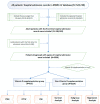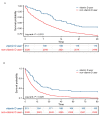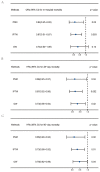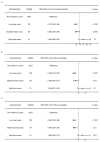Vitamin D Supplementation during Intensive Care Unit Stay Is Associated with Improved Outcomes in Critically Ill Patients with Sepsis: A Cohort Study
- PMID: 37447250
- PMCID: PMC10346786
- DOI: 10.3390/nu15132924
Vitamin D Supplementation during Intensive Care Unit Stay Is Associated with Improved Outcomes in Critically Ill Patients with Sepsis: A Cohort Study
Abstract
Background: Vitamin D, as a common micronutrient, has been widely used in critically ill patients. However, whether supplementation of vitamin D in adult patients with sepsis can improve their prognosis remains controversial.
Methods: Data from the Mart for Intensive Care IV database was used in this retrospective cohort study, and adult patients with sepsis were enrolled. Critically ill patients, admitted to intensive care units (ICUs) between 2008 and 2019 at the Beth Israel Deaconess Medical Center (BIDMC), were divided into the vitamin D supplementation group and non-vitamin D supplementation group. The primary outcomes were defined as all-cause in-hospital, 28-day, and 90-day mortality rates after admission to the ICU. A 1:1 propensity score matching (PSM), inverse probability of treatment weighting (IPTW), and overlap weighting (OW) analyses were used to minimize selection bias and balance the baseline demographic characteristics. Regression and survival analyses were performed to assess the association between vitamin D supplementation and clinical outcomes in patients with sepsis.
Results: In total, 3539 patients with sepsis were enrolled as study participants; of these, 315 were supplemented with vitamin D during their ICU stay. In-hospital, 28-day, and 90-day mortality rates were significantly lower in patients with sepsis supplemented with vitamin D. Multivariate regression analysis showed vitamin D supplementation as a potential protective factor for in-hospital mortality with an odds ratio (OR) = 0.70 (0.51-0.96) after adjusting for all confounders. The hazard ratios (HRs) for 28-day and 90-day mortality were 0.65 (0.50-0.85) and 0.70 (0.55-0.90), respectively. The survival analysis showed that the vitamin D supplementation group had a higher survival probability within 28 and 90 days (p-value < 0.05). These results remained relatively stable post PSM, IPTW, and OW. However, we found no evidence that vitamin D supplementation could shorten the length of stay in the ICU or hospital.
Conclusions: Vitamin D supplementation during an ICU stay was associated with improved prognosis in patients with sepsis, as evidenced by lower in-hospital, 28-day, and 90-day mortality rates and lower disease severity-related scores, but showed no influence on the length of stay in the hospital or ICU.
Keywords: intensive care units; mortality risk; prognosis; sepsis; vitamin D.
Conflict of interest statement
The authors declare no conflict of interest.
Figures





Similar articles
-
Vitamin D supplementation may be beneficial in improving the prognosis of patients with sepsis-associated acute kidney injury in the intensive care unit: a retrospective study.Front Med (Lausanne). 2024 Dec 2;11:1453522. doi: 10.3389/fmed.2024.1453522. eCollection 2024. Front Med (Lausanne). 2024. PMID: 39687902 Free PMC article.
-
Vitamin D supplementation during intensive care unit stay is associated with improved outcomes in critically Ill patients with sepsis: a cohort study.Front Cell Infect Microbiol. 2025 Jan 20;14:1485554. doi: 10.3389/fcimb.2024.1485554. eCollection 2024. Front Cell Infect Microbiol. 2025. PMID: 39902186 Free PMC article.
-
Association Between Dexamethasone and Delirium in Critically Ill Patients: A Retrospective Cohort Study of a Large Clinical Database.J Surg Res. 2021 Jul;263:89-101. doi: 10.1016/j.jss.2021.01.027. Epub 2021 Feb 24. J Surg Res. 2021. PMID: 33639374
-
Vitamin D in the ICU: More sun for critically ill adult patients?Nutrition. 2019 May;61:173-178. doi: 10.1016/j.nut.2018.11.001. Epub 2018 Nov 16. Nutrition. 2019. PMID: 30731421 Review.
-
Evaluation of Vitamin D Supplementation in Critically Ill Patients-A Narrative Review of Randomized Controlled Trials Published in the Last 5 Years.Nutrients. 2025 Feb 27;17(5):816. doi: 10.3390/nu17050816. Nutrients. 2025. PMID: 40077686 Free PMC article. Review.
Cited by
-
Update on vitamin D role in severe infections and sepsis.J Anesth Analg Crit Care. 2024 Jan 23;4(1):4. doi: 10.1186/s44158-024-00139-5. J Anesth Analg Crit Care. 2024. PMID: 38263252 Free PMC article. Review.
-
The Role of Vitamin D and Vitamin D Receptor in Sepsis.Curr Issues Mol Biol. 2025 Jul 1;47(7):500. doi: 10.3390/cimb47070500. Curr Issues Mol Biol. 2025. PMID: 40728969 Free PMC article. Review.
-
Vitamin D supplementation may be beneficial in improving the prognosis of patients with sepsis-associated acute kidney injury in the intensive care unit: a retrospective study.Front Med (Lausanne). 2024 Dec 2;11:1453522. doi: 10.3389/fmed.2024.1453522. eCollection 2024. Front Med (Lausanne). 2024. PMID: 39687902 Free PMC article.
-
A Comprehensive Review of the Immunomodulatory Effects of Vitamin D in Sepsis.Cureus. 2024 Feb 5;16(2):e53678. doi: 10.7759/cureus.53678. eCollection 2024 Feb. Cureus. 2024. PMID: 38455817 Free PMC article. Review.
References
-
- Takeuti F.A.C., Guimaraes F.d.S.F., Guimaraes P.d.S.F. Applications of vitamin D in sepsis prevention. Discov. Med. 2018;25:291–297. - PubMed
MeSH terms
Substances
LinkOut - more resources
Full Text Sources
Medical
Miscellaneous

